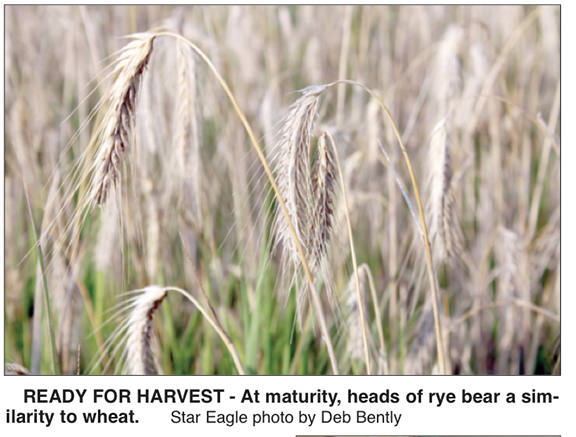 By DEB BENTLY
By DEB BENTLY
Staff Writer
“It is something of a surprise to see a combine in the field at this time of year,” admits Curtis Russell who, with his son David, operates about 200 acres of organic crops on their farm along Hound Street.
Russell says his family made the decision to begin using organic methods 15 to 20 years ago based on their feeling that the many chemicals and additives used in mainstream farming are part of a somewhat unhealthy pattern of relying on artificial substances.
“We thought we’d make a go at growing at least part of our crop organically, and it’s worked out pretty well for us overall.”
He explains that, to be certified organic, both the crop in the field and all records pertaining to it are audited annually. “And they’re pretty stringent,” he says. “The requirements are not easy to meet.”
The United States Department of Agriculture (USDA) has authorized only 16 agencies to certify crops in Minnesota. The Russells work with the Minnesota Crop Improvement Association out of the Twin Cities.
They also work with a crop consultant who tests the soils in their fields and advises them regarding crop rotation and management techniques. Since the Russell farm also operates two large turkey barns, turkey manure is an obvious natural choice for fertilization. “The consultant advises us about how much to use and when to apply it,” Russell explains.
Along with natural fertilizers comes a need for natural weed control. People might be surprised at the number of techniques available, Russell comments with a laugh.
Perhaps most exotic is a weed flamer.
The Russells built it using the framework of an old cultivator. Attached to the frame are jets which shoot flames in the rows of the crop, scorching the weeds. Depending on the height of the cash crop and whether it’s planted in rows or not, more traditional equipment such as cultivators, rotary hoes and drags are also sometimes used.
Perhaps the most natural approach of all, though, is one used by certain plants. Known as “allelopathic” properties, these indicate a natural chemical process which, according to the USDA, can suppress competing plants by inhibiting sprouting or discouraging root growth.
In the case of rye, which the Russells grow as a cash crop, the seeds are also placed densely and grow close together, helping create a physical barrier to weed growth.
Another element of the barrier is the timing of the planting. Rye seeds are placed in a freshly tilled field in the fall, preferably sometime in September. The seeds sprout and form a rich, green carpet about 8 inches tall before the weather turns cold and growth ceases.
“It can be really pretty to look at,” says Russell of the field which is green and lush at a time when other plants are changing color and dying.
The rye plants go dormant in the cold and remain that way through the winter. They are perfectly positioned in spring, then, to take advantage of the earliest warm days and continue growing.
“Because they’re so far ahead of other plants,” observes Russell, “their allelopathic properties are more damaging to other, newer growth.”
Depending on the year, rye plants finish their growth cycle and create seed heads about halfway through the warm months, and are ready to harvest while other crops are a month or more away from reaching maturity.
In good growing years, the Russells have harvested slightly more than 90 bushels of rye to the acre; since it was certified organic, it fetched a premium price.
The farm has sold its rye to companies which used it in various ways, ranging from being made into breads and other products for human consumption to selling it as feed, especially to farms handling meat or dairy animals whose products were to be certified as organic.
In the case of two particularly good years, the rye had done such a good job of suppressing weeds that even the straw of the plants became a premium product. Thanks to the absence of weed seeds and waste, the straw was baled and sold to a company which used it as mulch around large-scale construction products. Covering the exposed soil helped prevent erosion and suppressed weed growth.
Regrettably, and to no one’s surprise, the Russells’ 2022-23 rye crop is far from impressive.
Planted in ground already low in moisture after last year’s drought, it experienced a rather low germination rate and has failed to thrive against the heat and drought this summer has brought.
Shaking his head, Russell reveals they were tempted to simply plow the crop under, but decided that a small harvest would probably be better than none at all.
“It’s nice to hear the sound of a combine in the field, anyway,” he comments. “That’s how farming goes–you take your chances every year on what sort of harvest you’ll bring in.”
Regarding the challenges of raising organic crops, Russell says, “We certainly haven’t gotten it down to a science yet. We know there are some who are doing a great job…we’re still working at it.”
